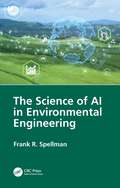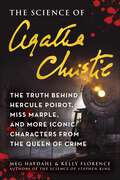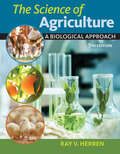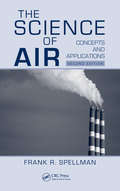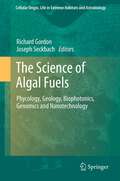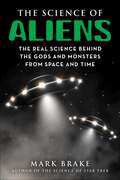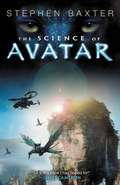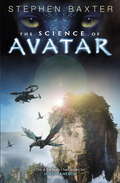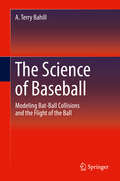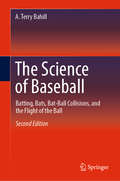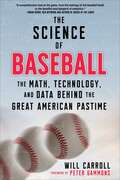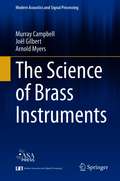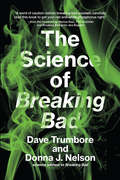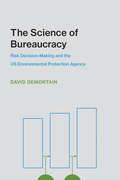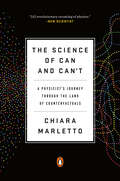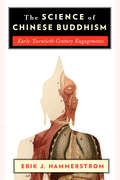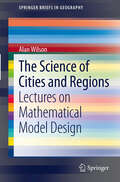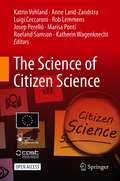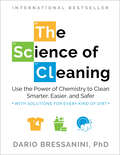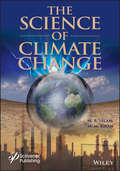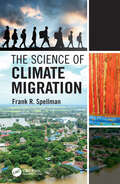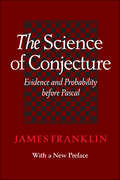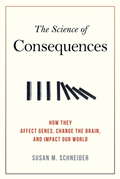- Table View
- List View
The Science behind the COVID Pandemic and Healthcare Technology Solutions (Springer Series on Bio- and Neurosystems #15)
by Abbas Rajabifard Sasan Adibi Sheikh Mohammed Shariful Islam Alireza AhmadvandThis book offers a timely review of modern technologies for health, with a special emphasis on wireless and wearable technologies, GIS tools and machine learning methods for managing the impacts of pandemics. It describes new strategies for forecasting evolution of pandemics, optimizing contract tracing, and for detection and diagnosis of diseases, among others. Written by researchers and professionals with different backgrounds, this book offers a extensive information and a source of inspiration for physiologists, engineers, IT scientists and policy makers in the health and technology sector.
The Science of AI in Environmental Engineering
by Frank R. SpellmanThis book explores the integration of artificial intelligence (AI) in environmental engineering, emphasizing the unique challenges and approaches required for the accurate modeling of physical phenomena. It clearly explains how AI should be developed and applied specifically in this field, offering definitions, examples, and practical guidance. It is designed to be accessible, featuring tables, figures, and illustrations to simplify complex topics like water hydraulics, air pollution, waste management, and more. Suitable for professionals in the field and students, this book explains the benefits of AI in environmental engineering and discusses the latest developments and environmental concerns.This book: Explains the nexus between artificial intelligence and environmental engineering Includes illustrative problems and solutions commonly used in current environmental practices Covers the latest AI developments and how they can be effectively applied to solve modern engineering challenges
The Science of Abolition: How Slaveholders Became the Enemies of Progress
by Eric HerschthalA revealing look at how antislavery scientists and Black and white abolitionists used scientific ideas to discredit slaveholders In the context of slavery, science is usually associated with slaveholders&’ scientific justifications of racism. But abolitionists were equally adept at using scientific ideas to discredit slaveholders. Looking beyond the science of race, The Science of Abolition shows how Black and white scientists and abolitionists drew upon a host of scientific disciplines—from chemistry, botany, and geology, to medicine and technology—to portray slaveholders as the enemies of progress. From the 1770s through the 1860s, scientists and abolitionists in Britain and the United States argued that slavery stood in the way of scientific progress, blinded slaveholders to scientific evidence, and prevented enslavers from adopting labor‑saving technologies that might eradicate enslaved labor. While historians increasingly highlight slavery&’s centrality to the modern world, fueling the rise of capitalism, science, and technology, few have asked where the myth of slavery&’s backwardness comes from in the first place. This book contends that by routinely portraying slaveholders as the enemies of science, abolitionists and scientists helped generate that myth.
The Science of Agatha Christie: The Truth Behind Hercule Poirot, Miss Marple, and More Iconic Characters from the Queen of Crime (The Science of)
by Meg Hafdahl Kelly FlorenceUncover the theories behind Dame Agatha Christie's most thrilling mysteries: Murder on the Orient Express, Death on the Nile, The A.B.C. Murders, and so much more! Gothic media moguls Meg Hafdahl and Kelly Florence, authors of The Science of Stephen King and co-hosts of the Horror Rewind podcast called &“the best horror film podcast out there&” by Film Daddy, present a guide to the Agatha Christie stories and supersleuths we all know and love. Through interviews, literary and film analysis, and bone-chilling discoveries, The Science of Agatha Christie uncovers the science behind the sixty-six detective novels and fourteen short story collections that have become an integral part of the modern murder mystery, answering such questions as: What is the science behind the poisons used to commit murders in Agatha Christie&’s stories? When did crime investigation become more common as seen in Murder on the Orient Express? Has science made it possible to uncover the truth behind the investigative powers of Hercule Poirot and Miss Marple? How did Agatha Christie use isolated settings to best explore the psychology of her characters? Join Kelly and Meg as they discover why sometimes the impossible must be possible!
The Science of Agriculture: A Biological Approach (Mindtap Course List Series)
by Ray V. HerrenTHE SCIENCE OF AGRICULTURE: A BIOLOGICAL APPROACH, Fifth Edition, masterfully introduces the biological sciences and explores the influences of these sciences on modern agricultural practices and the agricultural industry. <p><p>Reader-friendly and superbly illustrated, this highly practical text explains not only the "how" of agriculture, but also the "why" behind agriscience, presenting information on plant and animal systems, soils, cell functions, genetics, genetic engineering, plant and animal reproduction, entomology, biotechnology, and environmental concerns. <p><p>Additionally, the text spotlights career opportunities and discusses new directions in agriculture, including topics such as no-till crops, high-pressure processing in food preservation, fracking, and more, to further engage you with today's agricultural world.
The Science of Air: Concepts and Applications, Second Edition
by Frank R. SpellmanHailed on first publication as a masterful review of the topic, The Science of Air: Concepts and Applications quickly became a standard resource in the field. Clearly written and user-friendly, the second edition continues to provide the scientific underpinnings of the essence of air. Major expansions include:Air math and physicsAir flow parameters
The Science of Algal Fuels
by Richard Gordon Joseph SeckbachThis volume, The Science of Algal Fuels (volume 25 of COLE), contains 26 chapters dealing with biofuels contributed by experts from numerous countries and covers several aspects of algal products, one being "oilgae from algae," mainly oils and fuels for engines. Among the prominent algal groups that participate in this process are the diatoms and green algae (Chlorophyceae). Their metabolism and breeding play an important role in biomass and extraction of crude oil and algal fuel. There is a strong relation between solar energy influencing algal culture and the photobiology of lipid metabolism. Currently, many international meetings and conferences on biofuel are taking place in many countries, and several new books and proceedings of conferences have appeared on this topic. All this indicates that this field is "hot" and in the forefront of applied bioscience.
The Science of Aliens: The Real Science Behind the Gods and Monsters from Space and Time (The Science of)
by Mark BrakeDiscover the real science behind 2001, ET, Signs, and all your favorite fictional alien civilizations.As space telescopes continue to search for life in this unearthly Universe, the crucial questions remain unanswered. Are we awake to the revolutionary effects on human society and science that alien contact will bring? And how is it possible to imagine the unknown? The Science of Aliens tells the compelling story of how the portrayal of alien life has evolved over time.Taking examples from science, film, and fiction, this book showcases how scholars, filmmakers, and authors have devoted their energies to imagining life beyond this Earth. From Copernicus to Kubrick, The Science of Aliens is a fascinating account for anyone interested in extraterrestrials.Otherworldly topics include:What Xenomorphs from Alien and Na&’vi from Avatar have in commonDarwin among aliensExtraterrestrials in Einstein&’s skyAliens in our space ageAnd so much moreVisualize the unknown and redefine your place in a changing cosmos with The Science of Aliens.
The Science of Avatar
by Stephen BaxterAudiences around the world have been enchanted by James Cameron's visionary Avatar, with its glimpse of the Na'vi on the marvelous world of Pandora. But the movie is not entirely a fantasy; there is a scientific rationale for much of what we saw on the screen, from the possibility of travel to other worlds, to the life forms seen on screen and the ecological and cybernetic concepts that underpin the 'neural networks' in which the Na'vi and their sacred trees are joined, as well as to the mind-linking to the avatars themselves.From popular science journalist and acclaimed science fiction author Stephen Baxter, THE SCIENCE OF AVATAR is a guide to the rigorous fact behind the fiction. It will enhance the readers' enjoyment of the movie experience by drawing them further into its imagined world.
The Science of Avatar
by Stephen BaxterJames Cameron's Avatar is the biggest movie of all time. Now the movie's legendary director has leant his support to an exploration of the world of Pandora with bestselling science-fiction author Stephen Baxter. From journeys into deep space to anti-gravity unobtanium, from Pandora's extraordinary flora and fauna to transferring consciousness, Baxter and Cameron reveal that we are often closer to world of Avatar than we might imagine.Stephen Baxter is the master of `what-if?' science fiction. In THE SCIENCE OF AVATAR he's written a book that will appeal to fans of both science-fiction and popular science. THE SCIENCE OF AVATAR will offer fans the unique opportunity to explore the spectacular world of Pandora, from the creator himself.
The Science of Baseball
by A. Terry BahillThis book describes the dynamic collisions between baseballs, softballs, and bats, and the intricate modeling of these interactions, using only Newton’s basic principles and the conservation laws of physics. Veteran baseball science author Terry Bahill explains models for the speed and spin of balls and bats and equations for bat-ball collisions at a level accessible to high school and undergraduate physics students, engineering students, and, most importantly, students of the science of baseball. Unlike other, more technical accounts of these phenomena that exhibit similar rigor, the models presented in this volume use only basic physical principles to describe simple collision configurations. Elucidating the most important factors for understanding bat performance—bat weight, moment of inertia, the coefficient of restitution, and characteristics of humans swinging the bats, Dr. Bahill also explains physical aspects of the ideal bat and the sweet spot.• Explains how to select or design an optimal baseball or softball bat and create models for bat-ball collisions using only fundamental principles of mechanics from high school physics;• Describes the results of the collision between baseball and bat using basic mathematics such as equations for the speed of the ball after the collision, bat speed after the collision, and bat rotation after the collision;•Accessible to high school and undergraduate students as well as non-technical aficionados of the science of baseball. “Dr. Bahill’s book is the perfect tool for teaching how to solve some of baseball’s basic science problems. Using only simple Newtonian principles and the conservation laws, Dr. Bahill explains how to model bat-ball collisions. Also, he derives equations governing the flight of the ball, and proceeds to show what factors affect air density and how this density affects the ball’s flight. And as a unique addition to his fine book, he provides advice for selecting the optimal bat—a surprising bonus!”Dave Baldwin, PhDMajor League pitcher, 1966-1973, lifetime Major League ERA, 3.08 “If I were the General Manger of a baseball team, I would tell my people to write a ten-page paper describing what this book contains that could improve our performance. I think the book provides the foundation for change.”Bruce GissingExecutive VP-Operations (retired) Boeing Commercial Airplanes“[I] had a chance to read your research, and I fully agree with your findings.”Baseball Legend Ted Williams, in a 1984 letter to the author
The Science of Baseball: Batting, Bats, Bat-Ball Collisions, and the Flight of the Ball
by A. Terry BahillThis augmented, new edition adds discussion of the bat’s vertical sweetness gradient, eye-hand cross-dominance, models for the swing of a bat, and accuracy of simulations. The book retains its description of dynamic collisions between baseballs, softballs, and bats, and the intricate modeling of these interactions, using only basic math and physical principles. Veteran baseball science author Terry Bahill explains models for the speed and spin of balls and bats and calculations for bat-ball collisions at a level accessible to most students of the science of baseball. Demystifying the most important factors for understanding bat performance—bat weight, moment of inertia, the coefficient of restitution, and characteristics of humans swinging the bats—Dr. Bahill also explains physical aspects of the optimal bat and the sweet spot.Praise for the First Edition “Dr. Bahill’s book is the perfect tool for teaching how to solve some of baseball’s basic science problems. Using only simple Newtonian principles and the conservation laws, Dr. Bahill explains how to model bat-ball collisions. Also, he derives equations governing the flight of the ball, and proceeds to show what factors affect air density and how this density affects the ball’s flight. And as a unique addition to his fine book, he provides advice for selecting the optimal bat—a surprising bonus!”Dave Baldwin, PhDMajor League pitcher, 1966-1973, lifetime Major League ERA, 3.08 “If I were the General Manger of a baseball team, I would tell my people to write a ten-page paper describing what this book contains that could improve our performance. I think the book provides the foundation for change.”Bruce GissingExecutive VP-Operations (retired) Boeing Commercial Airplanes“[I] had a chance to read your research, and I fully agree with your findings.”Baseball Legend Ted Williams, in a 1984 letter to the author
The Science of Baseball: The Math, Technology, and Data Behind the Great American Pastime
by Will CarrollIn The Science of Baseball, sportswriter and injury expert Will Carroll shows how understanding the science behind the Great American Pastime helps fans appreciate its nuances and that it enhances, not detracts from the greatest game ever invented. Carroll, as well as several experts via interviews, covers topics like what makes the ball break, bounce, and fly; how material science and physics work together to make the bat function; how hitters use physics, geometry, and force to connect; sensors and cameras; injuries; and much more. Baseball aficionados and science geeks alike will better appreciate the game--no matter which teams are playing--after reading this comprehensive book!
The Science of Brass Instruments (Modern Acoustics and Signal Processing)
by Arnold Myers Murray Campbell Joël GilbertThis book provides an in-depth account of the fascinating but far from simple actions and processes that take place when a brass instrument is played. Written by three leading researchers in brass instrument acoustics who are also experienced brass players, it draws together the many recent advances in our understanding of the subtly interrelated factors shaping the musician's control of the instrument's sound. The reader is introduced to models of sound generation, propagation and radiation. In particular, the current understanding of the behaviour of the player's lips, the modes of vibration of the air column inside the instrument, and the radiation of sound from a brass instrument bell are explained. The functions of the mouthpiece and of mutes are discussed. Spectral enrichment arising from nonlinear propagation of the internal sound wave in loud playing is shown to be an important influence on the timbre of many types of brass instrument. The characteristics of brass instruments in contemporary use (including cornets, trumpets, french horns, trombones and tubas) are identified, and related to those of the great variety of instruments at earlier stages in the evolution of the brass family. This copiously illustrated book concludes with case studies of the recreation of ancient instruments and some of the current applications of electronics and information technology to brass instrument performance. While most of the material presented is accessible by a general readership, the topic of musical instrument modelling is developed at a mathematical level which makes it a useful academic resource for advanced teaching and research. Written by three internationally acknowledged experts in the acoustics and organology of brass instruments who are also experienced brass instrument players. Provides both an accessible introduction to brass instrument science and a review of recent research results and mathematical modeling techniques Represents the first monograph on the science underlying the design and performance of musical instruments of the brass family
The Science of Breaking Bad (The\mit Press Ser.)
by Dave Trumbore Donna J. NelsonAll the science in Breaking Bad—from explosive experiments to acid-based evidence destruction—explained and analyzed for authenticity.Breaking Bad's (anti)hero Walter White (played by Emmy-winner Bryan Cranston) is a scientist, a high school chemistry teacher who displays a plaque that recognizes his “contributions to research awarded the Nobel Prize.” During the course of five seasons, Walt practices a lot of ad hoc chemistry—from experiments that explode to acid-based evidence destruction to an amazing repertoire of methodologies for illicit meth making. But how much of Walt's science is actually scientific? In The Science of “Breaking Bad,” Dave Trumbore and Donna Nelson explain, analyze, and evaluate the show's portrayal of science, from the pilot's opening credits to the final moments of the series finale. The intent is not, of course, to provide a how-to manual for wannabe meth moguls but to decode the show's most head-turning, jaw-dropping moments. Trumbore, a science and entertainment writer, and Nelson, a professor of chemistry and Breaking Bad's science advisor, are the perfect scientific tour guides.Trumbore and Nelson cover the show's portrayal of chemistry, biology, physics, and subdivisions of each area including toxicology and electromagnetism. They explain, among other things, Walt's DIY battery making; the dangers of Mylar balloons; the feasibility of using hydrofluoric acid to dissolve bodies; and the chemistry of methamphetamine itself. Nelson adds interesting behind-the-scenes anecdotes and describes her work with the show's creator and writers. Marius Stan, who played Bogdan on the show (and who is a PhD scientist himself) contributes a foreword. This is a book for every science buff who appreciated the show's scientific moments and every diehard Breaking Bad fan who wondered just how smart Walt really was.
The Science of Bureaucracy: Risk Decision-Making and the US Environmental Protection Agency (Inside Technology)
by David DemortainHow the US Environmental Protection Agency designed the governance of risk and forged its legitimacy over the course of four decades.The US Environmental Protection Agency was established in 1970 to protect the public health and environment, administering and enforcing a range of statutes and programs. Over four decades, the EPA has been a risk bureaucracy, formalizing many of the methods of the scientific governance of risk, from quantitative risk assessment to risk ranking. Demortain traces the creation of these methods for the governance of risk, the controversies to which they responded, and the controversies that they aroused in turn. He discusses the professional networks in which they were conceived; how they were used; and how they served to legitimize the EPA. Demortain argues that the EPA is structurally embedded in controversy, resulting in constant reevaluation of its credibility and fueling the evolution of the knowledge and technologies it uses to produce decisions and to create a legitimate image of how and why it acts on the environment. He describes the emergence and institutionalization of the risk assessment–risk management framework codified in the National Research Council's Red Book, and its subsequent unraveling as the agency's mission evolved toward environmental justice, ecological restoration, and sustainability, and as controversies over determining risk gained vigor in the 1990s. Through its rise and fall at the EPA, risk decision-making enshrines the science of a bureaucracy that learns how to make credible decisions and to reform itself, amid constant conflicts about the environment, risk, and its own legitimacy.
The Science of Can and Can't: A Physicist's Journey through the Land of Counterfactuals
by Chiara MarlettoFrom a young British scientist, a groundbreaking exploration of a radically different approach to physicsThere is a vast class of things that science has so far almost entirely neglected. They are central to the understanding of physical reality both at an everyday level and at the level of the most fundamental phenomena in physics, yet have traditionally been assumed to be impossible to incorporate into fundamental scientific explanations. They are facts not about what is (the actual) but about what could be (counterfactuals).According to physicist Chiara Marletto, laws about things being possible or impossible may generate an alternative way of providing explanations. This fascinating, far-reaching approach holds promise for revolutionizing the way fundamental physics is formulated and for providing essential tools to face existing technological challenges--from delivering the next generation of information-processing devices beyond the universal quantum computer to designing AIs. Each chapter in the book delineates how an existing vexed open problem in science can be solved by this radically different approach and it is augmented by short fictional stories that explicate the main point of the chapter. As Marletto demonstrates, contemplating what is possible can give us a more complete and hopeful picture of the physical world.
The Science of Chinese Buddhism: Early Twentieth-Century Engagements (The Sheng Yen Series in Chinese Buddhist Studies)
by Erik J. HammerstromKexue, or science, captured the Chinese imagination in the early twentieth century, promising new knowledge about the world and a dynamic path to prosperity. Chinese Buddhists embraced scientific language and ideas to carve out a place for their religion within a rapidly modernizing society. Examining dozens of previously unstudied writings from the Chinese Buddhist press, this book maps Buddhists' efforts to rethink their traditions through science in the initial decades of the twentieth century. Buddhists believed science offered an exciting, alternative route to knowledge grounded in empirical thought, much like their own. They encouraged young scholars to study subatomic and relativistic physics while still maintaining Buddhism's vital illumination of human nature and its crucial support of an ethical system rooted in radical egalitarianism. Showcasing the rich and progressive steps Chinese religious scholars took in adapting to science's rising authority, this volume offers a key perspective on how a major Eastern power transitioned to modernity in the twentieth century and how its intellectuals anticipated many of the ideas debated by scholars of science and Buddhism today.
The Science of Cities and Regions: Lectures on Mathematical Model Design
by Alan WilsonA 'science of cities and regions' is critical for meeting future challenges. The world is urbanising: huge cities are being created and are continuing to grow rapidly. There are many planning and development issues arising in different manifestations in countries across the globe. These developments can, in principle, be simulated through mathematical computer models which provide tools for forecasting and testing future scenarios and plans. These models can represent the functioning of cities and regions, predicting the spatial demography and the economy, the main flows such as journey to work or to services, and the mechanisms of future evolution. In this book, the main principles involved in the design of this range of models are articulated, providing an account of the current state of the art as well as future research challenges. Alan Wilson has over forty years working with urban and regional models and has contributed important discoveries. He has distilled this experience into what serves as both an introduction and a review of the research frontier. Topics covered include the Lowry model, the retail model, principles of account-based models and the methods rooted in Boltzmann-style statistical modelling and the Lotka-Volterra approach to system evolution. Applications range from urban and regional planning to wars and epidemics.
The Science of Citizen Science
by Roeland Samson Katrin Vohland Anne Land-Zandstra Luigi Ceccaroni Rob Lemmens Josep Perelló Marisa Ponti Katherin WagenknechtThis open access book discusses how the involvement of citizens into scientific endeavors is expected to contribute to solve the big challenges of our time, such as climate change and the loss of biodiversity, growing inequalities within and between societies, and the sustainability turn. The field of citizen science has been growing in recent decades. Many different stakeholders from scientists to citizens and from policy makers to environmental organisations have been involved in its practice. In addition, many scientists also study citizen science as a research approach and as a way for science and society to interact and collaborate. This book provides a representation of the practices as well as scientific and societal outcomes in different disciplines. It reflects the contribution of citizen science to societal development, education, or innovation and provides and overview of the field of actors as well as on tools and guidelines. It serves as an introduction for anyone who wants to get involved in and learn more about the science of citizen science.
The Science of Cleaning: Use The Power Of Chemistry To Clean Smarter, Easier, And Safer-with Solutions For Every Kind Of Dirt
by Dario BressaniniThe definitive, science-backed guide to cleaning everything in your home in a safe, sustainable, evidence-based way “A great reference for anyone stumped by reluctant-to-leave dirt—and far cheaper than hiring a professional.”—Booklist Countless cleaning hacks for every kind of household dirt may vie for our attention, but how do we know which ones really work and which ones will only leave you with a sticky mess that doesn’t actually do the job? Scientific evidence comes to the rescue, as chemistry professor Dario Bressanini teaches you everything worth knowing about cleaning agents and processes (and dispels plenty of myths, too). He answers all of our most pressing housekeeping questions: Is it more efficient to wash dishes in the sink or in the dishwasher? Does bleach remove dirt? Which cleaning supplies should I buy, and which can I make at home? Can vinegar and baking soda actually unclog your drain? How can I most effectively tackle different types of stains? What can get rid of that stuff on my showerhead? Bressanini covers subjects like these by digging into chemistry basics such as solubility, pH, and concentration, bringing them out of the classroom and into the real-world chores that we deal with every day. Laundry, dishes, sinks, bathtubs, counters, floors, and more—no matter what you’re cleaning, this book explains how to choose the right tools for the task, save yourself unnecessary effort, and stay eco-friendly by avoiding waste. The Science of Cleaning reminds us that science can be both useful and exciting. With Bressanini’s help, you can keep your home, your belongings, and yourself clean—with the confidence that only centuries of advancements in chemistry can provide.
The Science of Climate Change (Wiley-Scrivener)
by M. R. Islam M. M. KhanIt has long been recognized that science is the pursuit of knowledge, knowledge is power, and power is political. However, the fantasy of science being apolitical is a hallmark legacy of the enlightenment era, an era that romanticized pursuit of knowledge, disconnected from the baggage of power, politics, and dogmatic assertions. Yet, while the age of information has exponentially increased our access to knowledge, we can see, as clearly as ever, that scientific knowledge is neither apolitical nor dogma-free, and it certainly is not disconnected from power. It is hard to imagine another era when the separation between science and politics has been this blurred as it is today. At the same time, it is true that no other topic than climate change has been so politically charged, with one side dominating the scientific narration and branding anyone opposing the mainstream as a “climate change denier,” and the other standing in staunch defiance that climate change exists. In an age of political and scientific turmoil, how can we navigate out way to coming towards a more objective understanding of the scientific issues surrounding the climate change debate? This book presents the current debate of climate change as scientifically futile, on both sides of the scientific, and often, political, spectrum. The climate change debate has become like obesity, cancer, diabetes or opioid addiction, which is to say that the debate should not be if these maladies exist, but rather, what causes them. Instead of looking for the cause and making adjustments to remove those causes from our lifestyle, a combination of the capitalist drive towards mass production and a lack of identifying the roots of the problems, new solutions, or substitutes, have been proposed as “quick fixes” to the problems. This book identifies the root causes of climate change and shows that climate change is real and it is also preventable, but that it can be reversed only if we stop introducing pollutants in the ensuing greenhouse gases. The book brings back common sense and grounds scientists to the fundamentals of heat and mass transfer, while at the same time disconnecting politicking and hysteria from true scientific analysis of the phenomenon of global climate.
The Science of Climate Migration
by Frank R. SpellmanThis book addresses the nexus between science and migration and examines how the two are inextricably intertwined. The Science of Climate Migration primarily addresses the science of global climate change and additionally examines how this change is more than a region being too hot, too cold, too dry, too wet, or too windy; rather it is also about heightened military tensions, political instability, and myriad other factors. History has shown that this change is felt most acutely in developing countries that are least equipped to adapt. This inability to adapt is considered to be a driver that motivates local residents to find “greener pastures” through migration. Further, the book discusses the increasing need for the implementation and utilization of non-polluting renewables for use in energy production as a means to stave off environmental crises. Features Examines how and why climate change effects and human migration are inextricably intertwined. Discusses the increasing need for the implementation of non-polluting renewables for use in energy production as a means to stave off environmental crises. Explains how wildlife is also sensitive to shifts in climate and how this in turn affects their migration as well.
The Science of Conjecture: Evidence and Probability before Pascal
by James FranklinHow did we make reliable predictions before Pascal and Fermat's discovery of the mathematics of probability in 1654? What methods in law, science, commerce, philosophy, and logic helped us to get at the truth in cases where certainty was not attainable? In The Science of Conjecture, James Franklin examines how judges, witch inquisitors, and juries evaluated evidence; how scientists weighed reasons for and against scientific theories; and how merchants counted shipwrecks to determine insurance rates.The Science of Conjecture provides a history of rational methods of dealing with uncertainty and explores the coming to consciousness of the human understanding of risk.
The Science of Consequences
by Susan M. SchneiderFeaturing illustrative human, pet, and wild-animal anecdotes, this book is a unique and fascinating introduction to a science that is truly epic in scope. Children quickly learn that actions have consequences. This elementary lesson is repeated again and again throughout adulthood as we adjust our behaviors according to the reactions they produce in the social and natural environment. Now, an internationally recognized biopsychologist, tells the story of how something so deceptively simple can help make sense of so much. Despite their variety, consequences appear to follow a common set of scientific principles and share some similar effects in the brain (specifically, in the so-called pleasure centers). Based on these principles, Schneider and other scientists have been able to create mathematical models of certain behaviors. And they have demonstrated that learning from consequences predictably activates genes and restructures the neural configuration of the brain-in humans as well as in animals. Consequences are an integral part of the nature-and-nurture system. The knowledge gained from this newly expanded science has many applications, as the author shows in examples from the home, the hospital, the classroom, and the boardroom. The science of consequences helps fight prejudice, free addicts of their destructive habits, and treat depression. It enriches the lives of pets and zoo animals. It also sheds light on our biggest societal challenges, where we must choose between short-term and long-term consequences.

